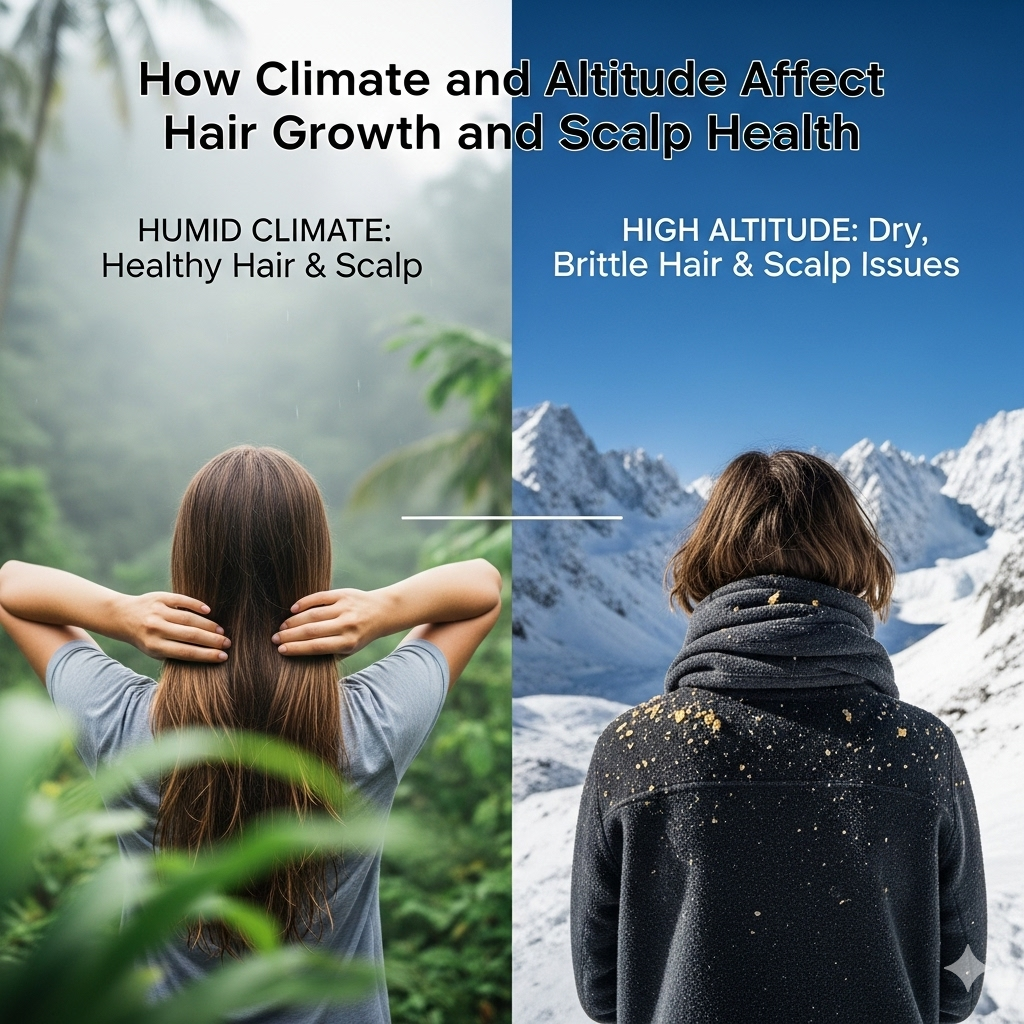Hair loss and scalp issues can be frustrating and complex. While genetics, hormones, and age are well-known contributors, many people overlook a crucial factor that plays a powerful role in overall hair health: the environment. Your local climate and altitude can significantly affect the strength, hydration, and behavior of your hair and scalp.
At ZMD Hair, we believe effective hair restoration starts with understanding all the variables influencing your follicles—including those in the air around you. In this blog, we’ll break down how climate and elevation affect your hair growth, what science says about environmental stressors, and how to protect and restore your scalp under varying conditions.
The Link Between Climate and Hair Health
Climate refers to the long-term patterns of temperature, humidity, and weather in a particular area. Whether you live in a humid coastal city or a dry, arid desert, your hair and scalp are constantly adapting to the environment. These adaptations can lead to either healthy, strong hair—or increased breakage and shedding.
Hot and Humid Environments
Warm, humid weather increases moisture in the air, which may sound good—but it’s a double-edged sword. On one hand, humidity can help keep the scalp hydrated. On the other hand, it can also:
- Weaken hair bonds, making strands more prone to frizz and breakage
- Promote fungal growth on the scalp, leading to dandruff or seborrheic dermatitis
- Cause excess sweating, which may clog pores and follicles with sebum and dirt
In short, while your scalp may not feel dry, it may be overwhelmed by moisture imbalance and microbial activity. This can lead to inflammation or blocked follicles—both potential contributors to hair thinning.
Cold and Dry Weather
In colder, drier climates, the air lacks moisture—especially in winter. As a result:
- The scalp becomes dehydrated, leading to flaking, itching, and inflammation
- Hair strands lose elasticity and are more likely to snap or split
- Circulation may slow, reducing nutrient delivery to hair follicles
Seasonal shedding is also more common in winter months, with studies showing that hair enters the shedding phase (telogen) more frequently in cold seasons.
Altitude and Hair Follicle Behavior
Altitude changes bring about a range of environmental stressors—including lower oxygen levels, colder temperatures, and increased UV radiation exposure. All of these factors can influence hair growth, sometimes in unexpected ways.
Lower Oxygen Availability
At high altitudes, oxygen levels drop. Since hair follicles rely on oxygen-rich blood flow, reduced oxygen availability can result in:
- Follicle dormancy or longer telogen (resting) phases
- Delayed regrowth of new hairs
- Increased likelihood of miniaturization, especially in individuals already predisposed to androgenetic alopecia
This doesn’t necessarily mean people living in mountain regions will all experience hair loss—but it does mean their follicles are operating under greater stress.
UV Radiation and Oxidative Stress
With altitude comes increased ultraviolet exposure. UV rays are known to:
- Trigger oxidative stress, which can damage scalp cells and weaken hair shafts
- Break down keratin and melanin in hair, leading to dryness, discoloration, and thinning
- Contribute to scalp inflammation and DNA damage in follicular cells
If you spend time at high elevation or under intense sun exposure, protecting your scalp is essential to maintaining hair integrity.
Scientific Evidence on Environmental Hair Stress
Emerging research supports the link between climate, altitude, and hair health:
- A study published in the International Journal of Trichology found that cold temperatures and low humidity significantly reduced hair diameter and density in participants, especially those with sensitive scalps.
- Research conducted by Environmental Health Perspectives revealed that long-term exposure to UV radiation alters gene expression in skin and scalp cells—impacting the hair growth cycle and increasing the risk of premature aging.
- Studies on high-altitude populations, such as in the Andes and Himalayas, show adaptive changes in vascularization and oxygen transport in the scalp. However, these adaptations can take years, and people visiting or newly living at altitude may face temporary hair shedding or slowed growth.
Protecting Your Hair Based on Your Environment
Understanding how your local environment affects your hair is the first step. The second step is learning how to adjust your hair care routine to match.
In Hot and Humid Areas
- Use clarifying shampoos to reduce buildup from sweat and oils
- Incorporate anti-fungal scalp treatments if prone to dandruff or inflammation
- Avoid heavy oils that may trap moisture and heat on the scalp
In Dry and Cold Regions
- Switch to hydrating shampoos and conditioners rich in ceramides or hyaluronic acid
- Use scalp serums or oils to restore lipid balance and prevent flaking
- Reduce heat styling, as dry air already saps moisture from hair
At Higher Altitudes
- Apply a broad-spectrum scalp sunscreen or wear a hat during sun exposure
- Focus on antioxidant-rich hair products to combat UV and oxidative damage
- Consider scalp massage to stimulate blood flow and oxygen delivery to the follicle
What About Hair Loss at High Elevation or Seasonal Moves?
Many patients report increased hair fall after relocating to a mountain town, traveling to a colder region, or during long ski trips. In these cases, hair follicles may temporarily pause growth or shift into a shedding phase as the body acclimates to new environmental stressors.
At ZMD Hair, we frequently see cases of temporary telogen effluvium triggered by altitude change, especially when paired with stress, dehydration, or poor nutrition. The good news? With supportive treatments and time, the follicles typically resume their normal growth cycle.
Supporting Hair Health Through Professional Care
Climate and altitude may not be in your control—but your hair care strategy is. At ZMD Hair, we take a holistic, personalized approach that factors in lifestyle, environment, and genetics. Whether you’re battling a dry, flaky scalp, struggling with seasonal shedding, or experiencing hair loss after a move to higher elevation, we offer targeted solutions including:
- Platelet-Rich Plasma (PRP) Therapy to awaken dormant follicles
- Topical medical treatments tailored for inflammatory or weather-induced loss
- Scalp hydration and detox plans based on climate conditions
- Oxygenation-enhancing scalp therapies for those living at high altitudes
Conclusion: Environment Plays a Bigger Role Than You Think
Hair health isn’t just about what’s happening inside your body—it’s also about what surrounds you. From extreme temperatures to dry air, UV rays to oxygen levels, the environment has a direct impact on your scalp and follicles.
If you’re noticing sudden changes in your hair after a move, a change in season, or an extended stay in a new climate, it might not be your imagination—it could be your body reacting to environmental stress. But you don’t have to just live with it.
Take the first step toward stronger, healthier hair.
Call (954) 302-6640 today or Visit ZMDHair to schedule your personalized consultation.




